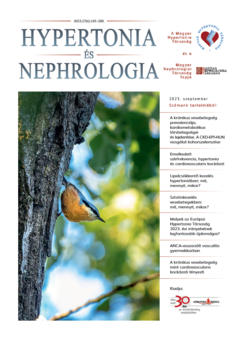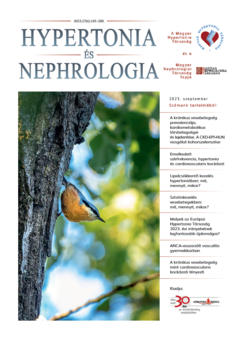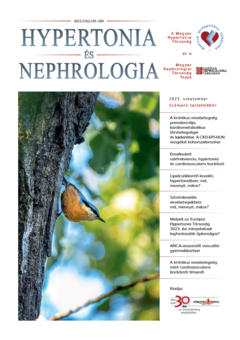The eLitMed.hu medical portal uses computer cookies for convenient operation. Detailed information can be found in the Cookie-policy.
Specialities
Cardiology
[Statin therapy in kidney patients: what, how much and when?]
[The association between an elevated cholesterol value and the risk of cardiovascular disease is well known. Over decades various classes of drugs were introduced to decrease cholesterol levels, but the real breakthrough came with the use of statins. In the population without renal disease numerous studies have proven statins to be effective in decreasing the level of lipids, in reducing cardiovascular risk, in delaying atherosclerosis and in the regression of plaque. Similarly, in the population with renal disease, many studies have justified the role of statins in reducing CV risk, especially in mild-moderate renal failure, but also in the population of patients requiring dialysis. Studies have also proven their effectiveness in slowing the progression of renal failure and in the reduction of proteinuria. They might also play a protecting role in contrast material-, aminogylcoside-, cardiac- surgery-induced acute kidney injury. Both the cardiac and the renoprotective effectiveness can be explained by summary of their lipid-decreasing and pleiotrop effects. Based on the increased CV risk proven in the population with renal disease, chronic kidney disease is in the high and very-high risk group in national and international guidelines. Reaching the determined lower target values in the high risk and very high risk group is only possible via aggressive antilipemic treatment. Out of statins, molecules capable of intensive decreasing of lipid levels are in favor, in case of ineffectiveness or even from start ezetimib (an agent inhibiting cholesterine uptake) can be added.]
[Melyek az Európai Hypertonia Társaság 2023. évi irányelvének legfontosabb újdonságai?]
[Húsz évvel az Alberto Zanchetti vezetésével összeállított és a nemzetközi tudományos életben rendkívüli mértékben elismert, az orvosi területen mindmáig a legtöbbet idézett első európai hypertonia-irányelv publikálását követően, az Európai Hypertonia Társaság (European Society of Hypertension – ESH) 2023. évi kongresszusán, Milánóban mutatták be a társaság új, a hypertonia ellátását segítő vezérfonalát. Az irányelv a kongresszussal egy időben került online publikálásra (1), a végleges publikáció jelen összefoglaló megjelenésekor, reményeink szerint, már olvasható a Journal of Hypertension augusztusi számában. Ez az irányelv a korábbi kettő kiadástól eltérően, amikor is az Európai Kardiológus Társasággal (European Society of Cardiology – ESC) közösen került kiadásra, az ESH egyedüli gondozásában jelent meg. ]
[Chronic kidney disease as cardiovascular risk factor]
[Chronic kidney disease (CKD) is one of the major risk factors for cardiovascular disease (CVD). More than 50% of patients with CKD die from CVD before starting dialysis. The relationship between CKD and CVD is explained by several mechanisms, including arterial stiffness, inflammation, oxidative stress, anaemia, calcium-phosphorus metabolism disorder and renin-angiotensin-aldosterone system activation. In order to reduce the cardiovascular risk of patients with CKD, it is important to recognize and treat CKD early, as well as to optimize the traditional and non-traditional risk factors. The aim of this review is to summarize the associations between CKD and CVDs, as well as the prevention and treatment options.]
[Beszámoló az Európai Hypertonia Társaság XXXII. kongresszusáról]
[2023. június 23–26. között Milánóban rendezték meg az Európai Hypertonia Társaság (European Society of Hypertension – ESH) XXXII. kongresszusát. A kongresszusra 958 absztraktot küldtek be, közülük nyolc Magyarországról származott. A kongresszus első napján, pénteken kora délután elsősorban az ESH különböző munkacsoportjai kaptak főtéma-lehetőséget, illetve a munkacsoportok közgyűléseire is ekkor került sor. Jómagam az ESH Working Group of Large Arteries-ének tagjaként ezen a szekción vettem részt, ahol szóba került az artériás érfalmerevség mérésének klinikai használatáról szóló, az év végéig tervezetten megjelenő konszenzusdokumentumának a helyzete. Ez az irányelv sokat segíthet a klinikusok számára a területet jelenleg övező számos bizonytalanság tisztázásában. Egy másik, a közeljövőben megjelenő közlemény a területhez köthető számos mérőeszköz validálásához is aktualizált iránymutatást fog nyújtani...]
[Evolution in medical therapy of heart failure with reduced left ventricular ejection fraction: clinical importance of the rapid titration strategy]
[Both, mortality and morbidity of chronic heart failure are persistently high, thus its adequate disease management is of pre-eminent importance. For heart failure with reduced ejection fraction (HFrEF) numerous evidence are available to improve its prognosis, including reduction of mortality, sudden cardiac death, and hospitalizations. Large randomized clinical trials have been shown that angiotensin-converting enzyme inhibitors (ACE inhibitors), angiotensin-receptor/neprilysin inhibitor (ARNI), B-blockers, mineralocotricoid receptor antagonists (MRAs) and sodium-glucose cotransporter-2 inhibitors (SGLT2 inhibitors) reduce both morbidity and mortality of HFrEF patients. Accordingly, the heart failure recommendation of the European Society of Cardiology (ESC) issued 2021, proposed the basic therapy for HFrEF in 4 pillars: ACEI/ARNI, BB, MRA and SGLT2 inhibitors.
Instead of the earlier approach of stepwise sequential therapy, the new recommendation advocates for simultaneous initiation of all four drug classes with rapid titration to the target dose. The STRONG-HF clinical trial aimed to compare the rapid titration with its conventional strategy. Concerning the primary composite endpoint of repeated heart failure in 180 days with rehospitalization and all-cause mortality compared with changes in quality of life and rehospitalization by heart failure as separate endpoints, the rapid titration was significantly more efficient solution.
When optimizing therapy, we have also to pay attention to the comorbidities of HFrEF patients, which may compromise the procedure of titration. The consensus document of the ESC Heart Failure Association recommends special patient profiling by comorbidities and specific hemodynamic parameters, followed by therapeutic recommendations on different patient profiles. Overall, SGLT2 inhibitors have the least limiting factors and contraindications, thus they can be used in all profiles without exception – as early as at initiating the therapy.]
[Bridge over the abyss – Recommendations and reality of lipid-lowering treatment]
[2023-ban evidenciaként kell elfogadunk azt a tényt, hogy az emelkedett LDL-C okozó rizikótényezője az atheroscleroticus érbetegségeknek és a következményként fellépő érkatasztrófáknak (myocardialis infarktus, stroke, perifériás érelzáródás). Intenzív lipidterápiával, azaz intenzív dózisú statin (20–40 mg rosuvastatin vagy 40–80 mg atorvastatin) és ezetimib kombinációjának alkalmazásával 50% feletti mértékben csökkenthető az LDL-C-szint, és így a kezeltek nagy részénél elérhetőek lennének a hazai és a nemzetközi ajánlásokban szereplő LDL-C-célértékek. ]
1.
Clinical Neuroscience
[Headache registry in Szeged: Experiences regarding to migraine patients]2.
Clinical Neuroscience
[The new target population of stroke awareness campaign: Kindergarten students ]3.
Clinical Neuroscience
Is there any difference in mortality rates of atrial fibrillation detected before or after ischemic stroke?4.
Clinical Neuroscience
Factors influencing the level of stigma in Parkinson’s disease in western Turkey5.
Clinical Neuroscience
[The effects of demographic and clinical factors on the severity of poststroke aphasia]1.
2.
Clinical Oncology
[Pancreatic cancer: ESMO Clinical Practice Guideline for diagnosis, treatment and follow-up]3.
Clinical Oncology
[Pharmacovigilance landscape – Lessons from the past and opportunities for future]4.
5.








